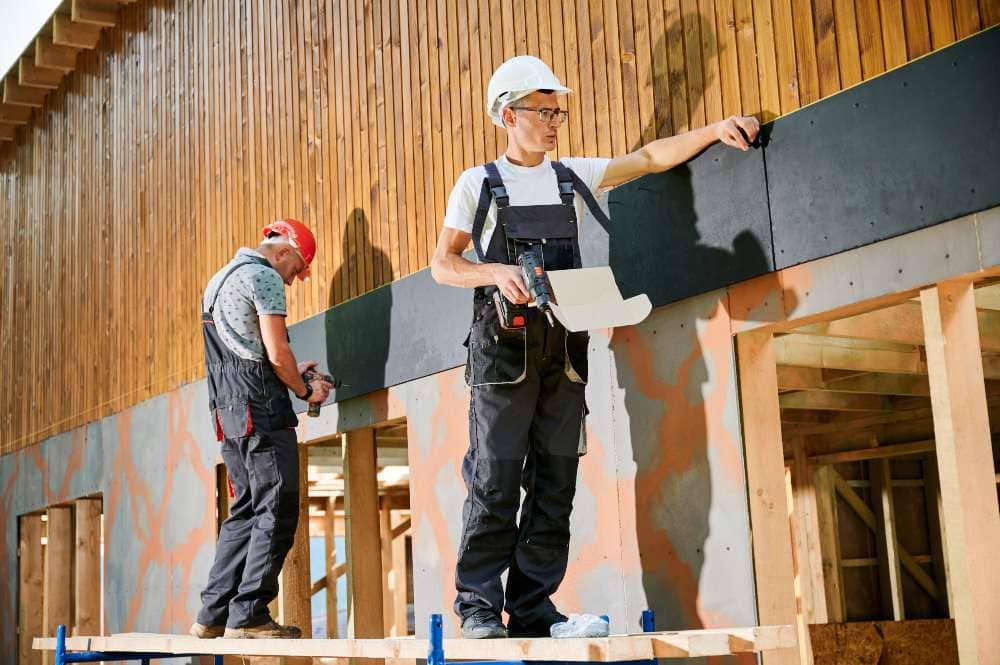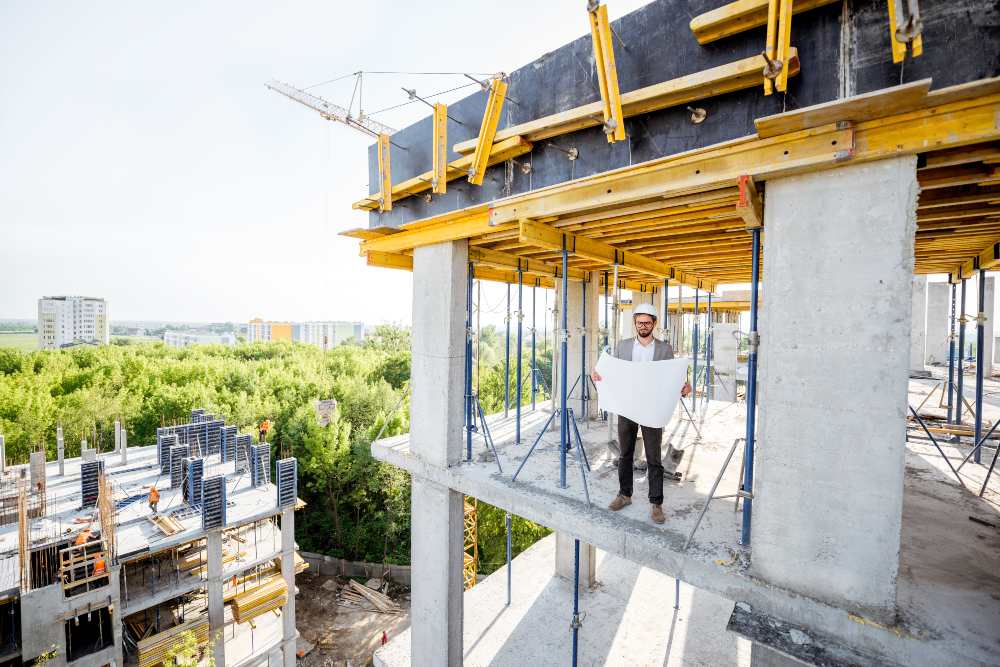So, what is formwork in construction? Formwork is an essential construction component that acts as a mould for concrete, enabling it to retain its shape as it hardens. Concrete formwork in construction projects across Australia is utilised to shape everything from massive infrastructure works to intricate architectural features. It serves not only as a temporary structure but can also be designed as a permanent fixture, contributing to the overall stability and finish of the concrete element.
The construction of formwork requires careful planning and execution. It involves assembling panels to contain the fresh concrete, accurately setting out the form to align with design specifications, and ensuring that it is structurally sound to withstand the pressures of pouring and curing concrete. The materials for formwork vary, including timber, metal, plastic, and fibreglass, each offering different benefits in terms of strength, durability, and ease of use.
Understanding formwork is crucial for those in the construction industry, as improper formwork can lead to structural failures, delays, and increased costs. Each project presents many unique challenges, and the choice of formwork directly impacts the concrete work’s efficiency, safety, and quality. With advancements in materials and design, formwork systems continue to evolve, supporting the construction industry’s drive towards more efficient and sustainable practices.
Understanding Formwork In Concrete Construction
Concrete formwork is a critical component in construction, serving as a mould to shape concrete until it hardens. It is a temporary or permanent structure that necessitates careful consideration regarding materials and design to ensure structural integrity.
Types and Materials Used
Formwork can be categorised based on the material used and the construction method. The main types of formwork include:
- Timber Formwork: It comprises plywood and timber. Its versatility makes it suitable for various shapes and sizes. However, it’s mainly used for smaller projects due to labour intensity.
- Steel Formwork: Highly durable and capable of creating larger structures with smoother finishes. It’s used in heavy construction due to its strength and reusability.
- Aluminium Formwork: Similar to steel but lighter, making it easier to handle and thus reducing labour costs. Aluminium formwork is also reusable, offering economic benefits.
- Plastic Formwork: Made from lightweight and robust plastic that can be used in a modular system, ideal for simple structures.
- Fabric Formwork: Involves flexible, high-strength membranes that can create innovative shapes in concrete.
The choice of material influences the concrete’s quality and finish and impacts the construction’s cost and speed.

Components and Functions
The function of formwork relies on its essential components, each serving a different type of specific purpose within the system:
- Mould: The surface that comes into contact with the poured concrete. It shapes the concrete to the desired form, whether using plywood for smaller projects or metal for more complex structures.
- Shuttering: Refers to the process of placing the panels against the concrete to hold it in place. Effective timber shuttering relies on the quality and treatment of the timber to resist the pressure of wet concrete.
The entire formwork system works symbiotically to maintain the desired shape out of concrete while providing the necessary support until it hardens and can support itself. Proper choice of formwork components and materials is fundamental to achieving desired outcomes in construction projects.
Ensure the success of your construction projects with Superior Concrete’s advanced formwork solutions. Visit our contact page or call 1300 826 505 for expert guidance.
Concrete Formwork in Construction Process
Formwork is an essential component of concrete construction in the construction industry, necessary for shaping structures accurately and safely. It involves creating and using temporary or permanent moulds into which concrete is poured. The design and method of erection and dismantling of formwork directly influence a project’s cost, timeline, and safety.
Design Considerations
The design of formwork systems, whether engineered formwork, modular systems, or more straightforward plywood formwork, mandates careful planning to ensure structure integrity and worker safety. In designing formwork, one must consider factors such as the weight of wet concrete, external loads, and the pressure exerted during concrete pouring and hardening.
Insulated formwork, which maintains a constant temperature during the curing process, enhances concrete strength and durability. The appropriate selection of materials, such as aluminium formwork for its lightweight and high-strength characteristics, can also provide significant advantages during construction.
Erection and Dismantling Methods
The methods used to erect and dismantle formwork play a pivotal role in the efficiency and safety of a construction site. Modular systems have revolutionised the erection process, providing a swift and reliable means of constructing formwork. They support the rapid progression of projects, aligning with tight timelines and reducing downtime.
Additionally, permanent formwork systems are used in specific structures, remaining in place to become a part of the finished building. This eliminates the dismantling process, saving time and reducing labour costs. In contrast, traditional systems may require extensive labour and are time-consuming to assemble and remove, underscoring the importance of selecting the most suitable formwork method based on project-specific requirements.
Economic and Quality Aspects
In assessing formwork, one must recognise its integral role in cost efficiency and project quality outcomes. These range from initial labour costs to long-term sustainability and maintenance.
Cost Efficiency and Budgeting
Cost Efficiency is paramount in formwork selection as it impacts the overall budget of construction projects. Formwork can significantly reduce costs through strategic use of resources and efficient labour practices. A recent analysis has shown that choosing the right type of formwork can control project expenses, minimising the likelihood of exceeding the budget due to unforeseen issues.
- Resource Usage: By optimising material use and reducing waste, formwork contributes to cost savings.
- Labour Costs: Effective formwork simplifies construction processes, reducing labour time and costs.
Durability and Maintenance
The quality of formwork directly influences the lifespan and durability of a structure. Proper formwork should maintain its shape and support, resisting wear and tear throughout the building’s life. According to industry standards, formwork must be robust, limiting the frequency and cost of maintenance.
- Sustainability: Selecting formwork that can be reused balances cost efficiency with environmental responsibility, aligning with sustainability principles.
- Durability: High-quality formwork ensures the concrete sets correctly, extending the structure’s lifespan and reducing future resource usage.

Safety and Regulations In The Construction Industry
In Australia’s construction industry, adherence to stringent safety protocols and regulations is paramount. The guidance provided by Safe Work Australia forms the foundation for maintaining high safety standards on sites where formwork operations occur.
On-Site Safety Measures
Identification of Hazards: The first step in the safety protocol is thoroughly identifying potential hazards associated with formwork. This includes risks from using heavy machinery to the stability of the formwork structure itself. Every aspect of the formwork process must be scrutinised, from the initial design to the final dismantling.
Use of Scaffold and Temporary Structures: Scaffolds and other temporary structures must be erected according to the General Guide for Scaffolds and Scaffolding Work. These structures should be regularly inspected for stability and strength to support the weight of the concrete, workers, and equipment assembled on site.
Training and Competence: Workers involved with formwork must be adequately trained and deemed competent. They should understand the process and the safety measures that protect them from falls, structural failure, and other construction-related hazards.
Personal Protective Equipment (PPE): The correct usage of PPE is non-negotiable. This includes helmets, safety harnesses, and other gear designed to protect against specific risks inherent to formwork operations.
Emergency Procedures: Clear emergency procedures must be established and communicated to all workers. These plans should include immediate measures for incident response and an outline of steps to rectify any breaches in safety protocols.
Regulatory Compliance: Compliance with local safety regulations is a legal requirement. The Guide to Formwork provides comprehensive information on managing the risks associated with formwork and ensuring that formwork design, construction, and dismantling are performed within Australia’s regulatory framework.
Maximise efficiency and safety on your construction site with Superior Concrete’s formwork systems. Reach out to us online or at 1300 826 505 to learn more.
Technological Advancements in Formwork
Concrete, Steel & Timber Formwork
The landscape of construction technology has seen a remarkable evolution, especially in formwork systems. Modern technology has facilitated significant strides in the efficiency and effectiveness of formwork, significantly improving project effectiveness. One notable innovation is the development of interlocking systems, which permit a faster and more reliable setup, reducing labour time and costs.
In response to the demand for versatility, high durability, and precision in construction, formply has emerged as a game-changer. This engineered plywood offers strength and durability, ensuring concrete structures are cured with a smooth finish and resilient form. It’s particularly favoured for its reusability and environmental benefits, cutting down on waste.
Advancements Impact on Formwork Interlocking Systems Streamline assembly and disassembly processes. Formply Provides a high-quality finish and is reusable.
Technology in traditional formwork now also reaches into the digital space, with software tools aiding in the design and planning stages. These tools ensure precise measurements and customisation for complex structures, saving time and materials.
Moreover, new construction materials and techniques are continually being developed, aiming to increase safety and reduce costs while also improving the structural integrity of the resulting concrete formations. This ongoing innovation gives the construction industry a promising outlook for future projects.

Main Takeaways
The article on formwork provides essential insights into its role in construction, highlighting the following key points:
- Definition and Importance: Formwork is a temporary or permanent mould used in concrete construction. It is crucial for shaping structures and ensuring their stability and finish.
- Materials and Types: Different materials, including timber, steel, aluminium, plastic, and fabric, are used for formwork, each suitable for specific project needs.
- Design and Execution: Proper design and careful erection of formwork are vital for the construction process’s efficiency, safety, and quality.
- Economic Impact: Strategic selection and use of formwork can significantly influence the cost-efficiency and budgeting of construction projects.
- Durability and Maintenance: High-quality formwork contributes to the longevity of structures, reducing long-term maintenance costs.
- Safety and Regulations: Following safety standards and regulations is paramount in formwork operations to prevent accidents and ensure worker protection.
- Technological Advancements: Innovations in formwork materials and digital tools are improving construction practices’ efficiency, safety, and environmental impact.
Looking for sustainable and cost-effective formwork options? Contact Superior Concrete today and discover our innovative solutions. Give us a call at 1300 826 505 for a consultation.

